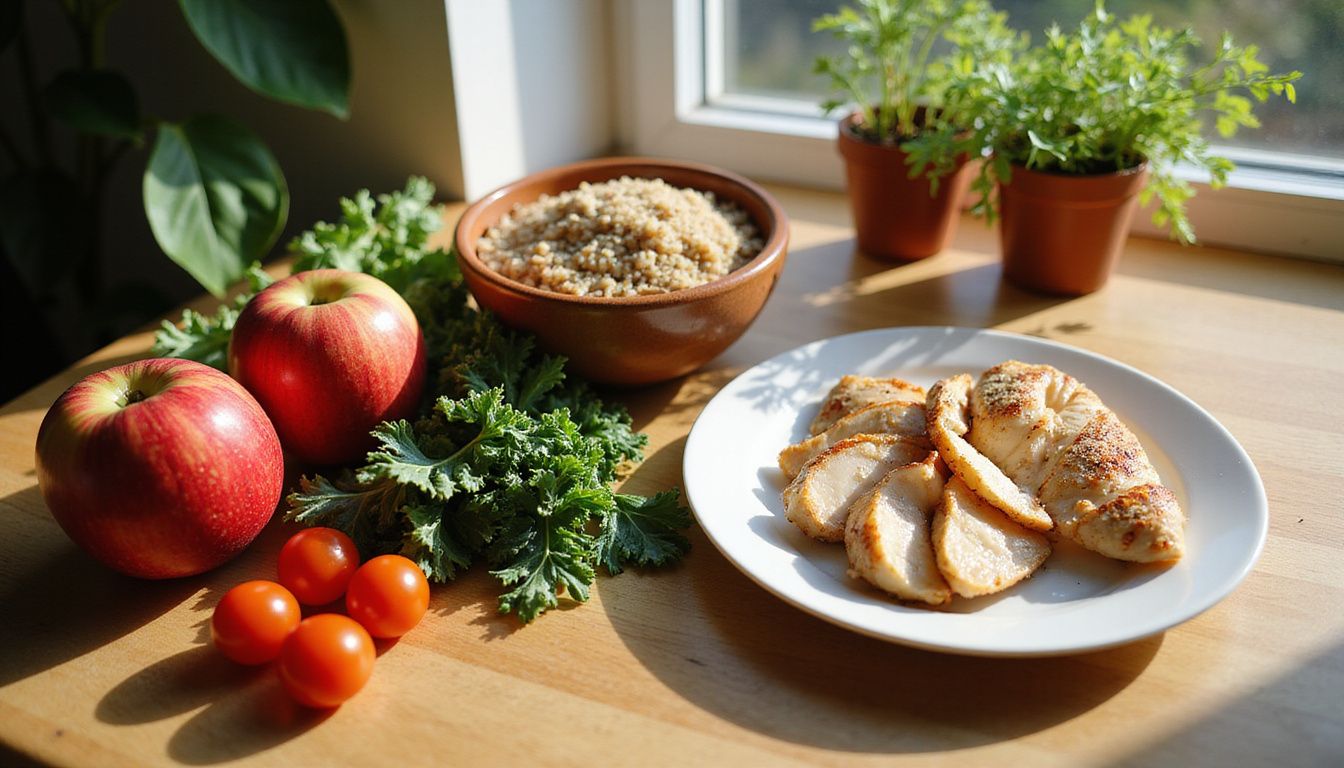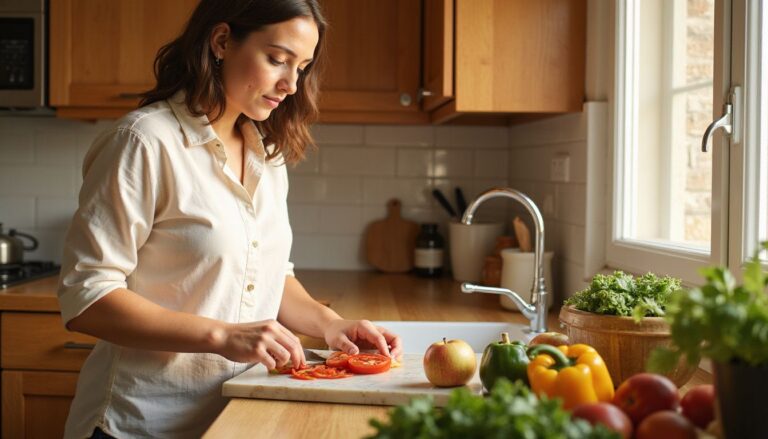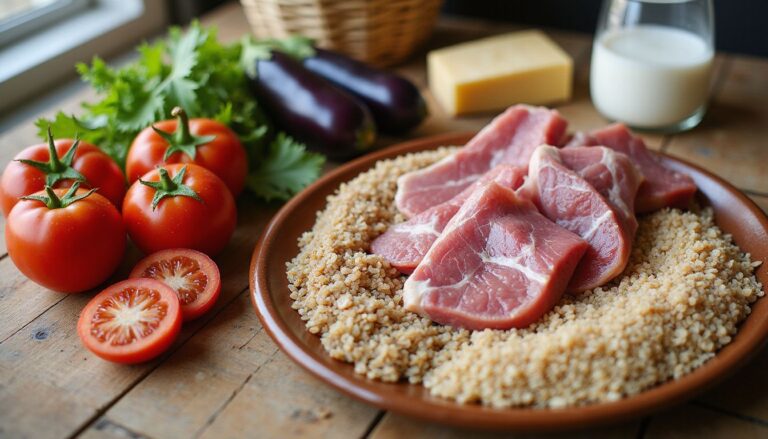Effective 2000 Calorie Meal Plan For Weight Loss: Sample Diet To Help You Shed Pounds
Our Nutrition Assistant AI Suite will transform your body. You will lose fat, get toned, and build muscle. Gain confidence and optimal health.
Losing weight while staying consistent with a healthy meal plan can feel tough. A 2000 calorie meal plan gives you a clear target so you can manage intake, meet nutrition needs, and still enjoy food.
This guide breaks down the plan into simple steps, sample meals, and practical tips. You will find ideas you can use today to reach your weight loss goals without guesswork.
Key Takeaways
- The 2,000 calorie meal plan is a common benchmark used by the Dietary Guidelines for Americans and MyPlate. It helps adults manage weight, track nutrients, and plan meals with ease.
- A balanced 2,000 calorie day often includes about 75 g protein, 264 g carbohydrates, 87 g fat, and at least 43 to 51 g fiber. Aim to keep sodium under 2,000 mg.
- Weight loss happens when you burn more calories than you eat. A weekly deficit near 3,500 calories can reduce body fat by about one pound.
- Choose whole grains, lean proteins, fruits, vegetables, nuts, and seeds. Keep refined carbs, ultra-processed foods, and added sugars low, under 100 to 200 calories per day.
- Calorie needs vary with age, sex, activity level, and health. Adjust the 2,000 calorie plan to fit your energy and weight loss goals.

What Is a 2000-Calorie Meal Plan and Who Is It For?

A 2,000 calorie meal plan is a helpful reference point for many teens and adults. Dietitians use it to guide maintenance or slow weight loss, depending on your activity level and individual calorie needs.
Why are 2,000 calories considered a standard daily intake?
Nutrition Facts labels use 2,000 calories as a simple yardstick. It makes it easier to see how a serving contributes to your daily values for nutrients like protein, fiber, and iron.
The Dietary Guidelines for Americans list 2,000 calories as a common reference intake for people age 14 and older. MyPlate and public programs use the same number to show balanced eating patterns.
Having one standard helps you compare foods and track intake. If a snack provides 10 percent iron on a 2,000 calorie diet, you can see what it adds to your daily goal right away.
“Using a consistent calorie value like 2,000 makes reading nutrition labels much easier,” says a registered dietitian.
“The 2,000-calorie standard gives everyone a common starting point for healthy meal planning.”
What factors affect individual calorie needs?
Calorie needs depend on age, sex, weight, height, and activity level. Teens and pregnant people usually need more calories to support growth or pregnancy. Men often need more than women because they tend to carry more muscle, and muscle burns calories even at rest.
Goals matter too. If you want to lose weight, you need a calorie deficit, which means eating fewer calories than you use. Cold weather, food access, and gut health can also influence how your body uses energy.
If calories in equal calories out, weight stays the same. Eating more than you burn leads to gradual weight gain. These differences explain why a 2,000 calorie meal plan fits many people, but not everyone.
Next, consider if a 2,000 calorie diet suits your weight loss target.
Can a 2,000-calorie diet help with weight loss?
For many adults, yes. If you eat more than 2,000 calories now, lowering intake to this level can create a steady deficit. About 3,500 calories equal one pound of body fat. Cutting near that amount per week can lead to roughly one pound of weight loss.
The 2020-2025 Dietary Guidelines for Americans list 2,000 calories as a reference point. Some people need more or less based on body size and activity. A calorie deficit is still the key driver.
Using a high protein, whole foods plan, I tracked my meals and chose vegetables like spinach, broccoli, and cauliflower. Sticking close to 2,000 calories kept me full and energized. Over a few weeks, my waist shrank. For others, 2,000 may be above maintenance, which could stall progress. Adjust as needed.
Key Components of a Balanced 2000-Calorie Meal Plan
A balanced 2,000 calorie meal plan mixes quality carbs, lean protein, and healthy fats. This combo supports steady energy, better hunger control, and weight loss.
How should proteins, carbs, and fats be balanced?
Aim for about 75 g protein, 264 g carbs, 87 g fat, and at least 51 g fiber per day. Build meals with lean proteins like chicken, fish, tofu, or eggs, complex carbs such as oats or whole grain bread, and healthy fats from avocado, nuts, or seeds.
Many nutrition pros suggest 20 to 30 percent of calories from protein, 45 to 55 percent from carbohydrates, and the rest from fats. Keep sodium low, around 1,980 mg per day, to support blood pressure and fluid balance.
Think of a lunch with grilled chicken, quinoa, and almonds. You get protein for muscle, carbs for energy, and fats for fullness. This balance makes portion control easier and helps with inflammation and blood pressure.
Why are fiber and hydration important for weight loss?
Dietary fiber, the part of plants you cannot fully digest, helps you feel full on fewer calories. Getting 43 to 51 g per day from fruits, vegetables, beans, and whole grains supports digestion and steadier blood sugar.
Fiber slows sugar absorption, which reduces spikes and crashes that trigger cravings. Drinking water, black coffee, or unsweetened tea hydrates you without extra calories. Many people mistake thirst for hunger. A glass of water before meals can help you eat less.
I found that sipping cold water before breakfast and lunch made a difference. Hunger felt calmer, and I stayed on track with my plan.
How to include healthy fats and lean proteins in your diet?
After fiber and fluids, focus on fats and protein. Add avocado or olive oil to salads and grain bowls. Eat fish like salmon or tuna twice weekly for omega-3 fats.
Choose turkey, chicken breast, eggs, tofu, or tempeh to get protein with less saturated fat. Nuts such as almonds or cashews make satisfying snacks, and nut butters on whole grain toast keep you full longer.
Plain low-fat yogurt or kefir provides protein, calcium, and probiotics without the added sugars in many sweet drinks. If you follow DASH guidelines, keep sodium below 2,300 mg per day.
Roasted chickpeas are an easy make-ahead protein topper. I often swap creamy dressings for mashed avocado. It tastes rich and adds heart-healthy unsaturated fat.
Foods to Include in a 2000-Calorie Meal Plan
Choosing mostly unprocessed foods makes it easier to hit your nutrition targets on a 2000 calorie plan. Here are smart picks that support weight loss.
What are the best whole grains to eat?
Pick brown rice, oats, bulgur, quinoa, farro, and millet. These grains keep the bran layer, which adds fiber and minerals. They digest slower than refined grains, so they keep you full longer.
One cup of cooked brown rice has about 3.5 g fiber plus magnesium and potassium. For a 2,000 calorie diet, the Dietary Guidelines for Americans suggest about 6 ounce-equivalents of grains daily. That can look like one slice of bread, one ounce of cereal, or half a cup of cooked rice or pasta per serving.
Swap white bread and sugary cereals for whole grains. Many people notice fewer hunger swings and better control of calories in and calories out.
Which fresh fruits and vegetables support weight loss?
Berries, apples, pears, and peaches are high in fiber and lower in calories. Melons are water rich and help you feel full. MyPlate suggests 2 cups of fruit daily on a 2,000 calorie plan.
Choose non-starchy vegetables often. Spinach, kale, peppers, zucchini, broccoli, tomatoes, cauliflower, bok choy, and chard are nutrient dense and low in calories. Fresh or frozen vegetables without sauces also help you limit sodium.
Starchy vegetables like sweet potatoes and winter squash provide more energy and fiber. They pair well with strength training, since they refill muscle fuel. Last summer, I upped my non-starchy vegetables at lunch. Cravings fell in the late afternoon.
What lean protein sources should you choose?
Good choices include turkey, chicken, lean beef, lamb, bison, and veal. These support a plan focused on weight loss and align with the Dietary Guidelines for Americans.
If you prefer seafood, try tuna, salmon, halibut, scallops, mussels, clams, or shrimp. They are lower in saturated fat and provide key nutrients, including omega-3 fats.
Plant proteins like chickpeas, black beans, cannellini beans, kidney beans, and lentils offer fiber and iron. Eggs supply all essential amino acids in one food.
Aim near 75 g protein daily on a 2,000 calorie diet. Very active adults may need more. Monitor energy, hunger, and recovery so you can adjust.
What healthy fats come from nuts and seeds?
Almonds, cashews, macadamias, and hazelnuts contain unsaturated fats that support heart health by helping lower LDL cholesterol. Choose nut butters with no hydrogenated oils or added sugars.
Sunflower seeds and pine nuts add essential fatty acids. One ounce of most nuts has about 14 g fat, mostly the healthy kind. These foods fit the MyPlate protein group and help with blood pressure control when you keep portions reasonable.
Sprinkle nuts or seeds on salads or oatmeal. You get more flavor and texture while staying within your fat target on a 2,000 calorie plan.
Foods to Avoid or Limit
Smart choices move you forward. Limiting certain foods makes it easier to keep calories and sodium in range during weight loss.
Why avoid processed and sugary foods?
Items like ice cream, candy, pastries, French fries, hot dogs, pizza, and chicken nuggets pack a lot of calories with few nutrients. The American Heart Association suggests keeping added sugars under 5 to 10 percent of daily calories, roughly 100 to 200 calories on a 2,000 calorie plan.
Too much added sugar can spike blood glucose, then drop it, which drives cravings. I swapped bakery treats for a homemade whole grain muffin, and energy swings improved within a week.
| Food Item | Calories from Added Sugars (per serving) | Nutritional Value |
|---|---|---|
| Ice Cream | ~140 | Low |
| Candy Bar | ~120 | Low |
| Baked Goods | ~100-250 | Low |
| French Fries | ~130 | Low |
Favor fresh fruit, vegetables, lean proteins, and whole grains. You will feel satisfied and find it easier to stick to your meal prep routine.
How do high-sodium packaged meals affect weight loss?
Packaged meals and snacks often contain a lot of sodium and refined carbs. Think bagels, white bread, crackers, cookies, chips, sugary cereals, and boxed pasta dishes.
Too much sodium can cause water retention. That may mask weight loss on the scale and leave you feeling bloated. A 2,000 calorie plan works best when sodium stays near 1,980 milligrams per day.
Fresh fruit, vegetables, whole grains, and home-cooked meals make it easier to hit that target and support heart health.
What are the risks of refined carbohydrates?
Refined carbs digest quickly and raise blood sugar fast. Foods like white bread, chips, cookies, crackers, and sugary cereals often crowd out healthier choices.
Fast spikes can leave you hungry again soon, which makes sticking to your meal plan tough. Studies link higher refined carb intake to increased obesity risk. Lowering these foods can improve fullness and support better long-term health.
Sample 3-Day 2000-Calorie Meal Plan
This 3-day sample shows how to build balanced meals that fit a 2,000 calorie target. Use it as a template and swap items to match your taste and culture.
What does Day 1 look like?
Start Day 1 with simple, whole ingredients. A bowl of old-fashioned oats with low-fat milk and fresh berries gives steady morning energy.
For lunch, try a strawberry and chicken salad with spinach for fiber and lean protein. Keep snacks modest, like almonds or Greek yogurt. Dinner can be baked salmon with zucchini and onions for healthy fats and key micronutrients.
This pattern reaches about 2,000 calories with nutrient-dense foods. It supports weight loss while keeping meals satisfying.
What are healthy breakfast options for Day 1?
A balanced breakfast sets the tone for your day and helps control hunger.
- Veggie omelet with 2 eggs, 1 cup spinach, 1/4 cup mushrooms, 1/4 cup broccoli, plus 1 cup sautéed sweet potatoes in 1 tablespoon olive oil.
- Baked Banana-Nut Oatmeal Cups with 2 clementines, about 421 calories.
- Steel-cut oats topped with almond butter and fresh berries.
- Nonfat Greek yogurt with chia seeds and mixed fruit.
- Whole grain toast with sliced avocado and a sprinkle of seeds.
- Cottage cheese with pineapple chunks. Look for low-sodium options.
- Drink water or herbal tea. Hydration supports digestion and energy.
A veggie omelet kept me full and focused through a busy morning meeting.
What snacks work well in the morning on Day 1?
Choose snacks that bring fiber, protein, and healthy fats. These reduce cravings and help you stay on plan.
- An apple with 2 tablespoons peanut butter, about 286 calories.
- A piece of fruit like a banana or an orange, roughly 60 to 100 calories.
- Greek yogurt with a small handful of seeds or nuts.
- Baby carrots or bell pepper strips with hummus.
- Small portion of trail mix with unsalted nuts, dried fruit, and pumpkin seeds.
- Drink water with every snack to support appetite control.
What is a balanced lunch for Day 1?
Pick a lunch that balances carbs, protein, fats, and fiber. It should keep you satisfied for hours.
- Mediterranean Tuna Pita with 1 whole wheat pita, 5 oz tuna, red onion, celery, a quarter avocado, and 1 tablespoon feta.
- Whole grains from the pita add fiber and lasting energy.
- Tuna supplies lean protein and omega-3s for heart health.
- Red onion and celery add crunch and micronutrients at low calories.
- Avocado and feta provide healthy fats and flavor in small amounts.
- Alternate option: veggie and hummus sandwich with 1 oz cheddar, about 440 calories.
- Balanced meals like this can reduce overeating later in the day.
Planning lunch the night before makes it easier to avoid impulse snacks.
What are good afternoon snacks on Day 1?
Choose a snack that holds you until dinner without blowing your calorie budget.
- One banana with 20 almonds, around 260 calories.
- Bananas give potassium and quick energy for the late afternoon lull.
- Almonds add magnesium and monounsaturated fats for heart health.
- Keep portions measured and ready in a small container.
- Rotate nuts or pair grapes with low-fat cheese for variety.
- Avoid processed snacks high in sugar and sodium.
- Drink water to support digestion and curb extra nibbling.
- Consistent snacks help you stick to a 2,000 calorie plan.
What healthy dinners can you have on Day 1?
Finish the day with a dinner that offers protein, vegetables, and smart carbs.
- Five ounces baked salmon drizzled with 2 teaspoons olive oil.
- One cup asparagus and 1 cup roasted eggplant for fiber and vitamins.
- One half cup wild rice for complex carbs and texture.
- Sheet-Pan Chicken Fajita Bowls with 1 cup brown rice, about 592 calories.
- Water with lemon or unsweetened herbal tea as your drink.
- Use smaller plates to support portion control.
- Season with herbs, spices, or citrus instead of salty sauces.
These choices fit a 2,000 calorie plan and help you end the day satisfied.
What does Day 2 look like?
On Day 2, start with whole grain bread for steady energy and better blood sugar control. Lunch can highlight colorful vegetables and fresh herbs. Dinner, like honey-soy chicken with mixed vegetables, delivers lean protein and key nutrients.
Planning ahead helps you stay near your 2,000 calorie target while feeling satisfied and alert.
What are nutritious breakfast ideas for Day 2?
Build breakfast around fiber, protein, and healthy fats. That mix keeps you on track for weight loss.
- Two slices whole grain toast with 2 tablespoons almond butter.
- Top with sliced banana and cinnamon for extra flavor and antioxidants.
- Power smoothie with 3/4 cup non-dairy milk, 1 cup spinach, 1 scoop protein powder, 1 cup blueberries, and 1 tablespoon hemp seeds.
- Greek yogurt with berries and chia seeds for calcium and probiotics.
- Scrambled eggs with cherry tomatoes and baby spinach, plus 1 slice whole grain bread.
- Steel-cut oats cooked in low-fat milk, topped with diced apple and chopped walnuts.
I prepped overnight oats with fruit last week. Energy stayed steady until lunch, and cravings went down. A simple calendar reminder helped me prep the night before.
What are good morning snacks on Day 2?
Small, balanced snacks prevent overeating at lunch and support focus.
- Sliced vegetables with 2 tablespoons hummus and half a whole grain pita, about 150 calories.
- Apple with 2 tablespoons peanut butter, about 286 calories.
- Greek yogurt with a handful of fresh berries for probiotics and fiber.
- Small banana with 12 raw almonds for a portable, balanced choice.
- Low-fat cottage cheese with pineapple or peaches for slow-digesting protein.
- Whole grain crackers with light string cheese for calcium and protein.
- Celery sticks with 1 tablespoon natural peanut butter.
What lunches support weight loss on Day 2?
Choose a lunch that fills you up and still supports your calorie goals.
- Black Bean and Sweet Potato Burrito: 1 whole wheat tortilla, 1/4 cup brown rice, 1/2 cup diced sweet potatoes, 1/4 cup black beans, 2 tablespoons salsa.
- Add 1 cup of mixed greens or spinach on the side for fiber.
- Drink a glass of water with your meal to support metabolism.
- Include half an apple or an orange for extra vitamins.
- Pick low-sodium salsa to help manage blood pressure.
- Use a smaller plate to support portion control.
- Swap in grilled chicken for beans if you want a different protein.
- Prep lunches ahead to reduce stress and prevent less healthy choices.
- Track calories if you can to stay near 2,000 for the day.
- Skip heavy dressings and extra cheese to avoid extra calories.
What afternoon snacks fit a 2,000-calorie plan on Day 2?
Pick snacks that blend protein, fiber, and healthy fat. They help control hunger and keep energy stable until dinner.
- Greek yogurt with strawberries and chia seeds. Yogurt is about 100 calories, berries add fiber.
- Two clementines, about 70 calories and rich in vitamin C.
- A small handful of raw almonds, around 80 calories and full of magnesium.
- Carrot sticks with hummus for fiber and plant protein.
- Cottage cheese with sliced peaches for calcium and protein.
- Whole grain crackers with low-fat cheese for steady energy.
- Apple slices with 1 tablespoon peanut butter for fiber and healthy fats.
What healthy dinner options are there for Day 2?
End the day with meals that deliver lean protein, vegetables, and whole grains.
- Chicken and Broccoli Stir-Fry with 5 oz chicken, 2 cups broccoli, 1/2 cup cooked brown rice, garlic, ginger, and 1 tablespoon soy sauce, about 400 calories and 40 g protein.
- Shrimp Pesto Penne with peas and a light amount of pesto for healthy fat and flavor.
- Grilled Salmon with 1/2 cup quinoa and 1 cup asparagus, around 450 calories.
- Turkey and Black Bean Lettuce Wraps with tomatoes for a high protein, high fiber choice.
- Vegetable Stir-Fry with firm tofu, peppers, snow peas, carrots, and brown rice.
- Baked Cod with a medium sweet potato and 1 cup green beans for a balanced plate.
- Chicken and Broccoli Stir-Fry is a reliable go-to. Fresh garlic and ginger add big flavor with minimal calories.
What does Day 3 look like?
Day 3 keeps the focus on whole foods and simple prep. For breakfast, sauté spinach, broccoli, mushrooms, and red bell pepper for a fiber-rich start.
Lunch can be a creamy tuna salad with yogurt dressing on fresh greens. For dinner, try tofu with black beans topped with tomato salsa. Meals like these are filling yet moderate in calories and sodium when you make them at home.
What are good breakfast smoothies for Day 3?
Smoothies make a quick breakfast that fits a 2000 calorie plan and helps you stay full.
- Power smoothie with 3/4 cup non-dairy milk, 1 cup spinach, 1 scoop protein powder, 1 cup blueberries, and 1 tablespoon hemp seeds.
- Oat, seed, and cherry smoothie for whole grains, fiber, and omega-3s.
- Use unsweetened almond or soy milk to reduce added sugar and boost calcium.
- Add one small banana for natural sweetness and potassium, about 100 calories.
- Greek yogurt, strawberries, and 1 tablespoon peanut butter for extra protein and healthy fat.
- Frozen fruit keeps the texture thick and cold without extra ice.
- The protein blueberry blend keeps me full until lunch and makes the morning easier.
What snacks are recommended in the morning on Day 3?
Pick a snack that balances protein and fiber so you feel steady until lunch.
- Medium banana with 2 tablespoons peanut butter, about 250 calories.
- Apple with 20 almonds, roughly 200 calories.
- Plain low-fat Greek yogurt with fresh berries, around 150 calories.
- Hard-boiled egg and a slice of whole wheat toast, about 170 calories.
- Cottage cheese with pineapple, near 160 calories.
- Baby carrots with hummus, about 120 calories.
- Low-fat string cheese for a portable protein boost, around 80 calories.
What lunch choices help with weight loss on Day 3?
Choose a lunch that is high in protein and fiber to control hunger through the afternoon.
- Creamy tuna salad on mixed greens. Lean protein plus fiber-rich vegetables make a filling, lower calorie meal.
- Chickpea and vegetable salad for plant protein and slow-digesting carbs.
- Grilled chicken with quinoa and steamed broccoli for essential amino acids and complex carbs.
- Turkey and hummus whole grain wrap with spinach and tomato slices.
- Lentil soup with a side of carrot sticks for soluble fiber and better blood sugar control.
- Wild rice bowl with grilled salmon, avocado, and cherry tomatoes for omega-3 fats and color.
- Cottage cheese with pineapple and walnuts for a quick, balanced option.
Pre-planning these lunches helped me skip the vending machine and stay within my calorie budget.
What are good afternoon snacks for Day 3?
Afternoon snacks should be nutrient dense and easy to pack. Use these options to stay satisfied until dinner.
- Greek yogurt with strawberries and chia seeds for protein and fiber.
- Two clementines for vitamin C and hydration.
- A small banana for convenient energy and potassium.
- Raw almonds for healthy fats and long-lasting satiety.
- Baby carrots with hummus for fiber and plant protein.
- Low-fat cottage cheese with pineapple for protein and vitamin C.
- Whole grain crackers with a slice of turkey breast for complex carbs and lean protein.
I often choose yogurt with berries. It curbs hunger and keeps me away from high calorie sweets.
What dinners fit a balanced 2,000-calorie plan on Day 3?
Close out Day 3 with meals that mix protein, vegetables, and whole grains. Keep sauces light and portions steady.
- Tofu with black beans and salsa for a plant-based, protein-rich dinner.
- Bean, squash, and tomato stew for a low calorie, high nutrient bowl.
- Grilled salmon or tilapia with roasted asparagus or green beans for omega-3 fats and fiber.
- Chicken breast stir-fried with broccoli, carrots, and snap peas in olive oil. Serve with brown rice.
- Lentil soup with spinach, tomatoes, onions, and celery for plant protein and soluble fiber.
- Turkey chili with kidney beans, bell peppers, onions, corn, cumin, and tomatoes.
- Baked sweet potato topped with cottage cheese and chives, plus steamed broccoli on the side.
I rotate these dinners during busy weeks. They are fast, flavorful, and help me meet my 2000 calorie goal.
Meal Prep Tips for Success
Meal prep boosts your chance of sticking with a 2000 calorie plan for weight loss. A few small steps each week can remove stress and save time.
How can planning meals ahead improve weight loss?
Planning ahead supports portion control and consistent meals. Cooking at home means you can choose nutrient-dense foods and limit ultra-processed items that add sugar and fat.
Batch cook staples and freeze extras for busy nights. That way you skip last-minute takeout and stay on track. Regular meal timing supports energy and appetite, which helps with weight control.
What are the benefits of batch cooking?
Batch cooking gives structure to your week. You make several meals at once, so your fridge and freezer are stocked with healthy options.
Prepare a few lunches like Chipotle-Lime Cauliflower Taco Bowls or hard-boil eggs for snacks. Research from the Harvard T.H. Chan School of Public Health links routine meal prep with better diet quality and improved weight control.
Setting aside two hours on Sunday to prep lunches kept me focused during tough work weeks. It also helped me avoid convenience foods that pushed me over my calorie target.
Why invest in quality meal prep containers?
Good containers help with portioning and keep food fresh. Tight seals prevent leaks and protect flavor for days.
Portable containers make it easy to bring meals to work or school. Clear labels and see-through lids let you track portions and nutrients at a glance. Glass or BPA-free plastic are popular for durability and safety.
These small upgrades can help you follow your meal plan and skip impulse buys.
Common Mistakes to Avoid
Small missteps can slow your progress on a 2,000 calorie plan. Learn the common traps so you can avoid them and keep moving forward.
Why should you not skip meals or snacks?
Skipping meals can lead to intense hunger later, which often causes overeating. Hunger hormones can rise, nudging you toward larger portions or sugary snacks.
Eating regular meals and planned snacks keeps energy steady. Studies show people who eat breakfast often feel more satisfied during the day. Structured eating helps your body get key nutrients at reliable times.
For me, regular meals cut down on energy dips in the afternoon. Staying ahead of hunger made it easier to resist packaged snacks.
Summary: Skipping meals often backfires. Regular, balanced eating supports better energy and steady weight management.
How do portion sizes impact your diet?
Portion size can make or break a 2000 calorie meal plan. Even healthy foods can push you over your daily target if the serving is too large.
The CDC notes that portions have grown a lot since the 1970s. A single restaurant plate can top 1,000 calories.
Home cooking gives you more control. Use measuring cups or a food scale to keep servings consistent. One cup cooked quinoa is about 220 calories. A medium avocado is around 240 calories. Tracking portions helped me prevent accidental overeating and stay within my goal.
What are the downsides of relying on processed
Ultra-processed foods often pack extra sodium, added sugars, and unhealthy fats. Frozen meals, chips, and sugary snacks use these ingredients to boost taste and shelf life. Eating them often can raise blood pressure and increase the risk of weight gain and type 2 diabetes.
Artificial sweeteners in diet products may not support weight loss as expected. Many refined carbs, like white bread and pastries, also spike blood sugar fast, which can drive hunger soon after. Building your menu around whole grains, fruits, vegetables, and lean proteins supports healthier weight control.
Safety note: If you have a medical condition, are pregnant or nursing, or take medications, talk with your healthcare provider or a registered dietitian before starting a new meal plan. Authoritative resources include the Dietary Guidelines for Americans, USDA MyPlate, the American Heart Association, and the Centers for Disease Control and Prevention.
FAQs
1. What is a 2000 calorie meal plan for weight loss and who should use it?
A 2000 calorie meal plan provides structured daily nutrition that supports gradual fat reduction while maintaining energy levels. This approach suits adults with moderate activity or those whose health professionals recommend this intake based on their unique needs. Research from the Dietary Guidelines for Americans shows that many adults maintain healthy body mass using about 2000 calories per day, depending on age, sex, and physical activity.
2. How can I structure my meals in a sample diet to reach 2000 calories each day?
Divide your food into three main meals and two snacks to help manage hunger and support steady metabolism. For example, breakfast might include oatmeal with berries; lunch could feature grilled chicken salad; dinner may offer salmon with brown rice and vegetables; snacks might be Greek yogurt or an apple with nut butter. The USDA Food Database lists average values: one cup of cooked oatmeal has about 150 calories, four ounces of grilled poultry contains roughly 180 calories, and one medium apple offers around 95 calories.
3. Will following a structured meal plan help me shed pounds more effectively than unplanned eating?
Evidence suggests planned diets improve adherence compared to spontaneous choices because they reduce guesswork and limit high-calorie temptations (Harvard T.H. Chan School of Public Health). In my own experience as someone who struggled with portion control before adopting a set menu, having clear guidelines made grocery shopping easier and helped track progress over several months.
4. Can I customize the foods in my effective meal plan if I have dietary restrictions or preferences?
Yes; you can swap ingredients within similar food groups to meet personal tastes or medical requirements without exceeding your target caloric intake. Registered dietitians often advise choosing whole grains instead of refined ones or plant-based proteins instead of animal sources when needed (Academy of Nutrition and Dietetics). Always check labels for nutritional content so substitutions fit your overall goal.
Summary: A well-designed 2000 calorie meal plan helps many people lose excess body fat by providing balanced nutrition through measured portions at regular intervals throughout the day. Customization allows flexibility for individual needs while supporting consistent results backed by scientific research.







